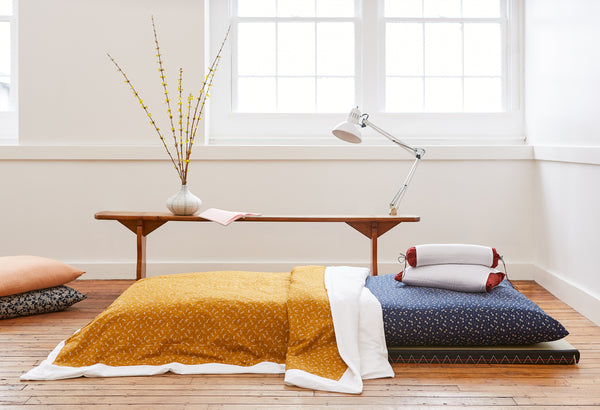A Japanese shiki futon mattress is one of the most versatile and practical additions to any home. A shikibuton is different from a bulky Western-style mattress. It can be easily folded or rolled. This makes it great for small spaces and rooms with many uses. You can put it directly on the floor as a guest room mattress. You can also set it on a futon frame for a simple sofa. Another option is to pair it with tatami mats for a comfy sleeping setup. For those seeking the best Japanese futon, its blend of tradition, flexibility, and comfort makes it a timeless choice.
If you plan to store your futon in a closet or use it as a sofa, you have many options. You can choose from futons made for occasional use as well as those built for everyday sleeping.
Find the right Japanese style futon for your needs with our guide below.

Start here: How Will You Use Your Futon Mattress?
The J-Life shikibuton mattress is designed to be used nightly as a bed, in place of a spring mattress and box spring. Our Japanese mattress can be used for a variety of alternative uses. You can use it for travel, when guests come over, or as a substitute for other furniture. The amount you want to invest and the comfort you seek from your futon mattress will vary. This depends on how you plan to use it along with how often.
Plan to use it as a sofa / guest bed?
If you plan to store your futon in a closet or use it as a sofa, you have many options. You can choose from futons made for occasional use as well as those built for everyday sleeping.
- Storage: If you plan to store your mattress, choose one that can be rolled or folded. It should be flexible enough to fit in your storage space. Thinner Japanese shikifuton mattresses are great for this. Our 3” thickness works well in smaller sizes, like cot or twin. We will talk more about this later in the guide.
- Comfort: If you want to use the mattress as a sofa or chair, choose one that feels good for sitting and lying down. Depending on the frame you use, a thicker mattress might be necessary so you don't feel the frame construction underneath.
- Aesthetics: The look of your mattress matters if your futon also serves as a sofa. It will be a big part of your decor. Our custom shikifuton covers can be swapped out and washed as they become soiled, or if your decor preferences change.
Plan to use your futon mattress as your everyday bed?
If you plan to sleep on your futon mattress every night, on the other hand, your priorities will be a little different.
- Comfort: Of course, you'll want the mattress you're sleeping on each night to be comfortable and supportive for your sleeping style. Choosing a thinner futon mattress on the floor is great for back-sleepers. However, stomach and side sleepers need a mattress with more cushion. Placing a tatami mat under our shikifutons adds extra cushion. It also helps you protect the longevity of your new mattress.
Our best-selling 4-inch shikifuton mattress has a great medium firmness. It suits most types of sleepers. Our 3-inch super firm shikifuton is the thinnest and firmest mattress we have. It comes in organic or all-natural options. Our 5-inch organic shikifuton is the thickest one we offer. This mattress is still considered firm, but less so than our 3-inch and 4-inch options. (We’ll talk more about the exact differences between our mattresses in the next section.)
- Quality: If you're using a mattress every night, it needs to hold up to extensive use. With proper care, a J-Life shikifuton can last decades or more. This makes them a more budget-friendly choice than an innerspring mattress. Innerspring mattresses can cost over $1,000 and last only about 5 years.
- Storage: If you live in a small space, like a tiny home or studio apartment, think about storage. Choose a mattress that can be easily stored away during the day. This will help create extra space. The shikifuton is perfect for this. You can tuck it away during the day to use your sleeping area.
Traditionally, the shikifuton is intended to be placed on the floor for sleeping. In Japan, a tatami mat is typically used underneath the shikifuton. These grass sleeping mats block moisture and let air flow under the mattress. They also add some cushion to your sleeping surface.
If you want to learn other ways to use your shikifuton, check out our blog on the topic.

Next: Choose Your Futon Mattress Material & Thickness
A real Japanese futon bed is usually made from cotton. However, today, other fillings are popular because they are cheaper to make. The prices and quality of these synthetic options are wide ranging.
At J-Life International, we aim to provide a traditional futon bed. Our beds follow the old tradition of the shikifuton. Below, we will talk about the downsides of popular synthetic shikifuton fillings. We will explain why we only use 100% cotton in our Japanese futons.
Memory-Foam Futon Mattress
- Do you tend to sweat or get warm easily when you sleep? If so, memory foam won't be your best choice, since foam mattresses tend to trap body heat.
- While memory foam beds may feel soft and squishy, they tend to lack support, which is not healthy for your muscles and joints in the long term.
- Most memory foam is made from a concoction of chemicals that aren’t great for the environment or your health. Standard memory foam is made from polyurethane and treated with flame retardants, both of which have been linked to a host of health problems. According to Sleepjunkie.org, a few of the chemicals that have been found on memory foam mattresses include:
- Methyl benzene - which can affect the nervous system.
- Dimethylformamide - a possible carcinogen.
- Methylene chloride - a solvent and a known mucous membrane irritant.
- Formaldehyde - a toxic chemical that is easily absorbed by inhalation.
- Vinilideine chloride - which can irritate eyes.
- Finally, many memory foam mattresses come vacuum-packed and take a few days to re-inflate. Once opened, they can give off a chemical smell for a few weeks. This happens as they release chemicals and odors into your home.
Innerspring Futon Mattress
- Innerspring foam mattresses are also often treated with fire retardants, including Melamine resin (which contains formaldehyde), Chlorinated tris (a possible neurotoxin and endocrine disruptor).
- Spring mattresses are notoriously uncomfortable and unreliable. After just a few years of consistent use, spring mattresses create pressure points that cause discomfort while sleeping and lasting pain.
- Like memory foam, spring mattresses can compress over time. This creates an uneven sleep surface. It can cause your neck and back to be misaligned while you sleep. This often results in uncomfortable, disrupted sleep as well as painful, achy mornings.
All Natural Cotton Shikifuton
Shikifutons are traditional Japanese futon mattresses. They are made of 100% cotton and meant for nightly use. They are still a popular choice in Japan today! Our shikibuton benefits include:
- This product is made from all-natural materials. The cover is 100% unbleached cotton duck. The fill is also made from 100% cotton. This ensures comfort and good air flow
- Rolls up and stores away easily.
- Known to ease back, neck, and joint pain, since they're designed to be placed on the floor for a firm sleep surface.
- You can buy optional covers. These covers are custom and removable. They are made from imported traditional Japanese fabrics or premium washable silk. These covers let you change the look of your bed.
- Easy to care for.
- The United States Consumer Product Safety Commission (USCPSC) requires all mattresses to contain some form of flame retardant. Our All-Natural Japanese Futon uses boron, which is safe for human health. You can rest easy knowing your mattress supports your health, not harms it. You can learn more about boron - and why we chose it - on our blog.
The J-Life All-Natural Shikibuton is available in two thicknesses: a 4-inch and a more traditional 3-inch. In Japan, modern shikibuton are about 3-inches thick. Our more popular 4-inch futon is made to accommodate those who like a softer sleeping surface.
Organic Cotton Shikifuton
Our Japanese organic cotton shikifuton mattress offers the same comfort and benefits as the all-natural shikifuton. However, it has a few differences:
- Made from exclusively organic materials: casing is 10 oz. certified organic cotton twill. The fill is also made from 100% certified American-grown organic cotton.
- The organic shikibuton meets US fire safety standards. It uses certified organic wool that does not have any boron.
The J-Life Organic Shikibuton comes in two thicknesses. You can choose a 3-inch traditional thickness or a 5-inch thickness, which is the thickest shikifuton we offer.

Lastly: Choose a Futon Size
Like most Japanese futon beds, ours come in standard mattress sizes: Cot, Twin, Twin XL, Full, and Queen.
| Cot | Twin | TwinXL | Full | Queen | King* |
| 30" x 75" | 39" x 75" | 39" x 80" | 54" x 75" | 60" x 80" | 78" x 80" |
For reference, below are our standard shikibuton sizes and recommended usage.
- Cot
The cot measures 30 inches wide and 75 inches long. It is our smallest shikifuton size. This makes it perfect for small spaces, travel, and easy storage. Fits one person.
- Twin / Twin XL
A twin size shikibuton is about 39 inches wide and 75 inches long. A twinXL shikibuton is 38 inches wide and 80 inches long. Both beds are wide enough for one person. The twin XL is 5 inches longer for taller people.
- Full
The J-Life full size shikibuton is about 54 inches wide and 75 inches long. It can fit one or two people who don’t mind a smaller sleeping area.
- Queen
Our queen size futon mattress runs 60 inches wide by 80 inches long. The queen size shikibuton is the most comfortable option for sleeping two adults.
- King*
At J-Life, we don’t have a king size shikibuton. However, you can make one by placing two twinXL shikifutons next to each other. This creates a 78-inch by 80-inch sleep surface that can comfortably fit two people (and probably a few pets, too!)


8 comments
I have already purchased one of these futons! It’s great and I’ve been sleeping well without any back pain in the morning. However I need to know if the cotton futon is washable. And if so how would I clean it. I’m a clean freak so I just need to know.
how do you clean cat urine stains or stains in general? Can’t find any info on cleaning… please advise. Love my J-Life Futons.
Has Anyone experienced a strong odor from their shikibuton?
I am asking for recommendations on how to eliminate it thanks!